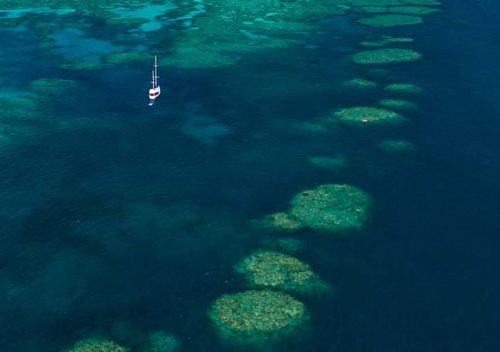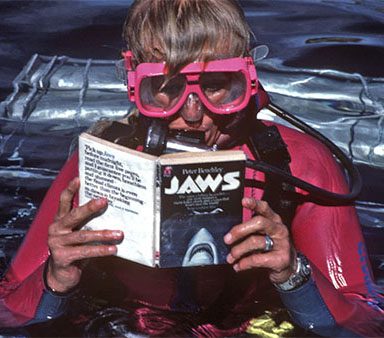Marine scientist Dr Simon Pierce is a leading authority on whale sharks. Co-founder of the Marine Megafauna Foundation, and advisor to the global whale shark database, his work on the population ecology and management of this iconic species has made him the world’s top whale shark conservation biologist.
Simon is co-author of the first scientific textbook on whale sharks, soon to be published, and he shares some fascinating whale shark facts with us here, answering his most-asked questions.
1. How big do whale sharks get?
Based on published fossil info, they’re still the largest fish to have ever lived. Sorry Megalodon fans, but your puny predator is practically petite (actually, very slightly smaller, but don’t kill my buzz) compared to whale sharks, the greatest fish of all time.
Anyway, the largest measured whale sharks have been about 18.8 m / 62 ft (from India) to 20 m / 66 ft (from Taiwan). Increasingly, though, we’re thinking these were outliers. Recent work by Mark Meekan and team over in Western Australia has convincingly argued that whale sharks don’t keep growing through their whole lives – most males stop at 8–9 m, and females at 14–15 m. That’s still pretty gigantic though, so… don’t kill my buzz. Source: Meekan et al. 2020.

2. Why is it that most known whale shark aggregations are mainly populated by males?
Whale sharks were only discovered by Western scientists in 1828. Until the 1980s, there had only been a few hundred encounters with the species. Even Jacques Cousteau only ever saw two. These days, we’ve identified a few areas where they gather in major constellations.
Whale sharks are highly food-motivated – they’re basically oceanic Labradors – so they tend to be found in places that have a high density of prey. Interestingly, though, it’s almost exclusively the male whale sharks that frequent these areas. Adult and subadult male whale sharks will both harass juvenile females (also boats, whale shark researchers, etc.), so that’s one good reason for the females to avoid them. However, this male bias persists even in places where no large males are present.
Maybe productive feeding areas attract more predators? For males, the main aim is just to eat lots and grow fast to reproductive size, so riskier habitats might be worth it. Females benefit (in evolutionary terms) by playing the long game, so they could be elsewhere. Smart. Still, this male bias is present almost everywhere we see whale sharks. I suspect there’s more to it. What’s the answer, then? I honestly don’t know. We haven’t seen many clear differences between the sexes yet, but… we’re mostly studying males, because we know where they are! I figure it’s most likely that females are feeding on slightly different prey, found elsewhere (presumably offshore, otherwise we’d be seeing them) but there’s little direct evidence of this so far.
The best way to answer this conundrum will likely be through long-term tracking studies that allow us to directly compare and contrast habitat preferences between the sexes. We can also use biochemical techniques to look at long-term diet and habitat use across populations. It’s still a bit of a mystery. We’re looking into it though. Clearly needs lots more research.
3. What do we know about the lifecycle of whale sharks?
This is a (highly speculative) overview of the whale shark’s life. Adult females are giving birth… somewhere… and there are lots of babies. Other pelagic sharks, like blues and makos, use ‘pelagic nurseries’, and – given the lack of whale shark babies we’ve seen – I suspect whale sharks are doing that too.
We do see coastal feeding constellations in quite a few countries. That’s where most whale shark tourism takes place. With only a few exceptions, it’s mostly juvenile males that use these areas (often 70–90%). The rest of the juvenile females are… somewhere else… presumably feeding more in the open ocean. We rarely see adult sharks close to the coast, and it’s particularly uncommon to see adult females. At this stage of their lives, they are highly oceanic, so the places we see them most often are remote volcanic islands, like Darwin in the Galapagos.

There’s probably some opportunistic mating behaviour in frontal zones in the open ocean. The place where people are most likely to observe it is around oceanic islands, like St. Helena in the Atlantic. It’s about 50/50 females/males there, and the only place I’ve personally seen whale shark courtship behaviours.
4. How far do whale sharks travel?
Whale sharks routinely swim more than 10,000 km each year. How do we know? We use tags that can transmit to satellites, allowing us to unobtrusively track their movements through the open ocean. This video shows Jonathan Green applying a fin-mounted tag in the Galapagos Islands. You can see the shark is completely unbothered. This is a great way for us to follow a shark’s travels for up to a year or so (the tag falls off eventually). Check out the Galapagos Whale Shark Project for more information.
5. How do whale sharks feed?
Whale sharks have an efficient filtration system that enables them to feed on fish eggs less than 1 mm in size. A medium-sized whale shark (~6 m) can filter over 600,000 litres of seawater an hour. To put that in perspective, it’s (exactly) like 600,000 bottles of milk. That could make 40 million cups of tea. Enough to last the average British household about a week. Astonishing.

6. How can you distinguish female whale sharks?
For the most part, we can’t tell the sexes apart in sharks… except males have external reproductive organs (claspers) and females do not. In whale sharks, though, we can. As females get close to adulthood, they develop a ‘bump’ behind the pelvic fins. Ultrasounds of this area haven’t revealed anything besides the normal skin and muscle tissue so far, but there’s clearly *something* going on with it. Anyway, the most important question is… what should we call this sexually dimorphic feature? I’m leaning towards peduncabutt, but open to suggestions.

7. How old do whale sharks get?’
We can – probably, kinda – age whale sharks through the ‘centra’ in their vertebral column. Shark skeletons are made of cartilage, not bone, and the centra continually grow in size as the cartilage accretes.
Like a tree, the shark’s centra will accumulate a dark (dense) band during times of slow growth, and a lighter band as it grows faster, when water temperature heats up or there’s lots of food around. So, each ‘band pair’ can represent one year… like a tree. Makes sense, yes? Actually no. Whale sharks – and you can trust me on this, I’m a doctor – are not trees. They can swim. Remarkably well. Whale sharks feel no obligation to suffer through winter, or limited feeding opportunities; they can just go somewhere else to stay warm or find food. That is likely to mess with the band formation.
Whale sharks become adults at about 7–9 m in males, and about 9 m in females. Age-wise, our current best guess is that corresponds with about 25 years in males, and 30–40 years in females. Compare that to us humans, who become adults (biologically) at 10–16 years, roughly. Whale sharks are very slow growing. Cameron Perry led some great work on this topic for his MSc project through the Maldives Whale Shark Research Program.
Let’s look at maximum age, then. If we know about how old whale sharks are at, say, 9 m, we can extrapolate out to the largest sharks. Makes sense, yes? Well, again… not really. Once they get to around their adult size, whale shark growth slows down dramatically. They may still form bands in the centra, but there’s a good chance they’ll be indivisible to our eyes / microscopes. The relationship between the shark’s size and age breaks down completely. So, yeah, that doesn’t help much.

So how old do whale sharks get? I don’t know. If I absolutely had to guess, I tend to say ‘about 100’, because that usually shuts people up. But yeah, in reality, it’s an open question. We’re going to have to use some fancy techniques to figure this out, and we’re not there yet. Watch this space, I guess.
Bonus Question! Where can I purchase the book?
Whale Sharks: Biology, Ecology, and Conservation



